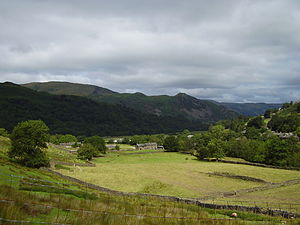Arnison Crag
| Arnison Crag | |||
| Westmorland | |||
|---|---|---|---|
 Arnison Crag (right of centre) from Hartsop | |||
| Range: | Lake District Eastern Fells | ||
| Summit: | 1,421 feet NY393150 54°31’36"N, 2°56’22"W | ||
Arnison Crag is a fell in the Lake District, an outlier of the Fairfield group in the Eastern Fells. It is in Westmorland and looks down on Patterdale village and the upper reach of Ullswater.
Landscape
Although properly a north eastern ridge of Birks and having little topographical prominence, Arnison Crag was classed as a separate fell by Alfred Wainwright in his Pictorial Guide to the Lakeland Fells. In support of his decision he referred to it as "a low hill with a summit worthy of a mountain.".[1]
Birks, which is itself a satellite of St Sunday Crag, resides on a southwest to northeast ridge. Below the summit and about halfway down the main slope, a level spur juts out eastward and then curves around to the north to run parallel with Birks. At the far end of this subsidiary ridge is the rocky summit of Arnison Crag. The slight col where the Arnison Crag ridge connects to the flank of Birks is Trough Head.
To the east of Arnison Crag is the lower portion of Deepdale and the settlement of Bridgend. This flank is rough and includes Aiken Crag and the face of Arnison Crag itself, just below the summit. To the west, separating the fell from the main ridge of Birks, is Hag Beck. This flows northward from Trough Head, passing through the woods of Glenamara Park before issuing into Grisedale Beck just above the main road. Glenamara Park was once a deer park and now contains much broadleaved woodland. Its retaining wall is still largely intact.
The ridge from Trough Head to Arnison Crag is fairly level and passes over a series of knolls. One of these- about halfway along- is the true summit, being 1,421 feet[2] high. Wainwright and later guidebook writers [3] have chosen to ignore this top because it is grassy and too far back to give an adequate view. North of the summit, the ground drops steeply over two tiers of rock outcrop, the lower one being Oxford Crag. Arnison Crag meets the valley floor directly behind Patterdale village.
Geology
There is evidence of former mining activity on the Deepdale slopes of Arnison Crag. Two levels were worked for haematite just above Deepdale Hall.[4] Geologically the summit of the fell is andesite, with the underlying Deepdale Formation of volcaniclastic sandstone revealed on the north western face.[5]
Summit
The summit is a low rock tower, attractively seen from the surrounding valleys. There is only a very small cairn due to the lack of available stone.[3] The view is largely restricted by higher fells, but with the Fairfield and High Street fells well seen.[1]
Ascents
Ascents can be made from Patterdale village, either direct up the nose of the ridge, or by curving round to the west and following the Glenamara Park wall. Trough Head can also be reached from either Deepdale or Hag Beck, providing an approach from 'behind' the summit. Arnison Crag is often climbed as the first part of the ascent of St Sunday Crag. From here the walker can either circuit Deepdale via Fairfield, Hart Crag and Hartsop above How or swing north around Grisedale, taking in Dollywaggon Pike, Nethermost Pike and Helvellyn.
References
- ↑ 1.0 1.1 Wainwright, Alfred: A Pictorial Guide to the Lakeland Fells, Book One — The Eastern Fells (1955)
- ↑ "Arnison Crag". web page. Stridingedge.net. 2013. http://www.stridingedge.net/wainwright%20fells/a-l%20fells/Arnison%20Crag.htm. Retrieved 27 February 2013.
- ↑ 3.0 3.1 Richards, M: Lakeland Fells, Near Eastern Fells: Collins (2003): ISBN 0-00-711366-8
- ↑ Adams, John: Mines of the Lake District Fells: Dalesman (1995) ISBN 0-85206-931-6
- ↑ Woodhall, DG: Geology of the Keswick District- a brief explanation of the geological map. 1:50,000 Sheet 29: British Geological Survey (2000)